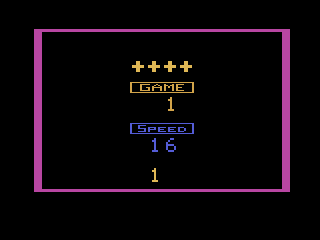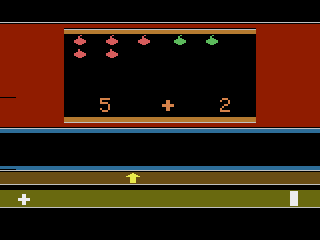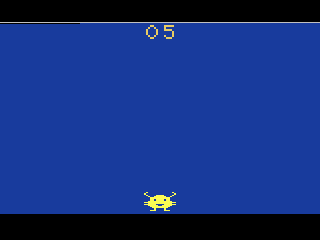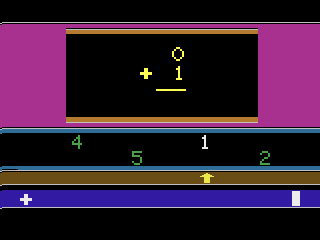Retro Replay Review
Gameplay
Eli’s Ladder sets its foundation on a simple yet effective mechanic: answer a series of math problems correctly to help Eli climb higher on his ladder and ultimately return to his spaceship. Each question presents four possible answers, and the player toggles the right joystick left or right to highlight their choice before pressing the action button. This direct mapping of movement to answer selection keeps young learners engaged and gives immediate feedback on whether their solution was correct.
The game offers three distinct modes—Practice, Pacer, and Phantom—each tailored to different learning paces and skill levels. In Practice mode, there is no time limit, allowing children ample opportunity to think through each addition or subtraction problem. Pacer mode introduces a moving timer bar that slides from left to right; if it reaches the barrier before an answer is chosen, the question is marked wrong and the next problem appears. Phantom mode ups the challenge by hiding all but the selected answer, so players must commit to their choice without previewing other options.
Controls are straightforward enough for children to grasp quickly. In single-player mode, the game advances automatically after each question. For a parent–child session, the left joystick serves as a way for parents to manually advance to the next problem, start the game, or count apples in the bonus counting screen. The use of two joysticks fosters cooperative play, letting parents guide the session and track progress. Difficulty switches on the console allow for instant toggles between one or two players and addition or subtraction, ensuring that the game can grow with the child’s proficiency.
Graphics
Graphically, Eli’s Ladder embraces the charming simplicity of early 8-bit visuals. Eli himself is rendered as a colorful, cartoonish character whose hops and jumps are delightfully bouncy. The ladder rungs and the backdrop of a starry sky are crisp and child-friendly, drawing young players into the whimsical world without overwhelming them with unnecessary detail.
The user interface is clean: math problems appear at the top of the screen in bold pixelated font, while the four answer choices line up neatly at the bottom. In Pacer mode, a small plus or minus sign glides smoothly along a bar beneath the answers to indicate the time remaining. On correctly solving 18 or more out of 20 questions, a flashing word “WOW” bursts across the screen in bright white, providing a gratifying visual reward.
When players switch to the counting apples screen, the graphics shift to a simple orchard scene dotted with shiny red apples, each of which can be booped to tally up items visually. Though not cutting-edge by modern standards, the art style remains perfectly tailored to the target audience, ensuring clarity of information and a warm, encouraging atmosphere throughout the educational journey.
Story
At its core, the narrative of Eli’s Ladder is delightfully minimalistic: Eli has lost his way and needs help climbing back to his spaceship. This straightforward premise is ideal for younger players, as it keeps the focus firmly on the math challenges rather than complex plot twists. Every successful answer advances Eli one rung closer to the stars, turning each correct calculation into a tangible, on-screen achievement.
The story unfolds organically through gameplay, with no lengthy cutscenes to interrupt the learning flow. After 20 questions, Eli finally reaches his spaceship. If the player has mastered at least 18 questions, Eli performs a jubilant leap for joy before boarding, and the word “WOW” flashes triumphantly, reinforcing the sense of accomplishment. This tight integration of narrative and gameplay ensures that young learners stay motivated without getting bogged down in exposition.
For those using the two-player mode, the interaction between parent and child can become its own mini-story. Parents can guide the next question, comment on Eli’s progress, and cheer each other on as Eli ascends. This collaborative dynamic enhances the basic storyline by making it a shared adventure rather than a solitary task.
Overall Experience
Eli’s Ladder succeeds admirably as an educational game for early learners. Its combination of clear controls, increasing difficulty levels, and immediate visual feedback creates a satisfying loop that encourages kids to keep trying until they master addition and subtraction. The ability to adjust speed and mode via the console switches means that the game can be as forgiving or as challenging as the player needs.
The inclusion of a parent-controlled advancement in two-player mode is a thoughtful touch that turns homework time into quality family time. Parents can monitor each answer and offer gentle guidance, transforming practice sessions into interactive teaching moments. Meanwhile, the counting apples feature provides a welcome break from arithmetic problems and reinforces number recognition in a playful way.
While modern titles may boast flashier graphics or sprawling narratives, Eli’s Ladder remains a standout for its singular focus on fundamental math skills and its warm, supportive presentation. For families seeking a straightforward educational experience that blends fun and learning seamlessly, Eli’s Ladder is a climb worth taking.
 Retro Replay Retro Replay gaming reviews, news, emulation, geek stuff and more!
Retro Replay Retro Replay gaming reviews, news, emulation, geek stuff and more!








Reviews
There are no reviews yet.